Why You Should Immediately Stop Using and Never Consider Male-to-Male Extension Cords
What is a Male-to-Male Extension Cord?
A male-to-male extension cord is a cable with male (pronged) plugs on both ends, as opposed to the conventional extension cord with a male plug on one end and a female socket on the other. These cords are not standard and are usually homemade or custom-made for specific, often improper, applications.
Double-male extension cords, often referred to as “Suicide Cords” or “Widowmakers,” are extremely dangerous and should never be made or used for any application. These cords pose significant safety risks, which is why their use is strongly discouraged. Instead, there are safer and legally approved alternatives available to serve the same purposes.
Uses of Double-Male Extension Cords
While male-to-male extension cords are not designed for safe or legal use, they are often employed inappropriately for the following purposes:
- Temporary power supply: They are used in emergency and power outage to restore the power via generator to the home supply circuits for a short time period.
- Powering a device or circuit through a wall outlet: Commonly referred to as “backfeeding,” this involves connecting a generator to a household circuit by plugging it directly into an outlet.
- Extending connections for DC power systems: This includes applications in solar panels or battery setups where a reverse current connection might be needed.
- Workarounds in improper wiring setups: When users attempt to bypass conventional wiring requirements.
These uses are typically born out of ignorance of the dangers or as makeshift solutions for electrical problems.
Why Are Male-to-Male Extension Cords Dangerous?
The design of a male-to-male extension cord inherently violates basic electrical safety principles. The dangers include:
- Exposed Live Prongs: When one end of the cord is plugged into a live outlet, the prongs on the other end become energized, posing a severe electrical shocks hazard.
- Improper Circuit Connections: These cords can lead to backfeeding, which energizes circuits that are supposed to be off, creating a risk for utility workers and others.
- Risk of Overloading Circuits: Male-to-male cords are often used in scenarios where load calculations are not considered, leading to overheating and potential fires.
- Lack of Overcurrent Protection: These cords bypass built-in safety mechanisms like circuit breakers or fuses, increasing the risk of short circuits.
Risks Associated with Male-to-Male Extension Cords
Male-to-male extension cords, often called “suicide cords”, are extremely dangerous and should never be used. Here’s why they are hazardous and why their use should stop immediately due to the specific risks posed by double-male extension cords.
Electrical Shock
Male-to-male cords have prongs on both ends. Once one end is plugged into an outlet, the exposed prongs on the other end are energized and can cause severe electric shocks if touched or anyone who comes into contact with the energized end. This setup exposes live metal components that are usually protected in standard cords.
Some male-to-male cords often lack proper grounding, increasing the risk of electrical faults and shocks.
Overloading & Fire Hazards
Overloaded circuits, improper grounding, or short circuits caused by male-to-male cords can ignite fires, especially in residential or commercial setups.
These cords bypass the designed circuit protections, potentially causing the circuit to overheat, leading to fires. If improperly used with incompatible devices, it can lead to severe overloads.
Damage to Appliances
Incorrect voltage or reversed polarity caused by improper connections can damage sensitive electronic devices.
Lethal Backfeeding
When backfeeding occurs, it energizes the neutral line and can send power to external circuits like utility poles, endangering utility workers repairing lines.
Male-to-male cords are often misused to connect a generator to a house’s electrical system. This practice, called backfeeding, sends electricity backward through the power lines.
This endangers utility workers who might assume the line is de-energized. It can damage the generator and connected appliances when power is restored.
Violation of Electrical Safety Standards
Male-to-male extension cords do not comply with National Electrical Code (NEC) or other safety standards. Using them can result in fines, voided insurance claims, or legal consequences.
Using such cords can have legal and financial consequences, void insurance claims, lead to regulatory penalties, and even result in lawsuits in the event of injuries or property damage.
What Are the Safer Alternatives to Male-to-Male Extension Cords?
- Properly Designed Extension Cords: Use standard cords with male and female ends, ensuring they are rated for the intended load. For example, Female-to-Male extension cords, Multi-Outlet extension cords, three-pronged extension cords, power strips with surge protectors, GFCI extension cords and other UL-Listed cords.
- Manual Transfer Switches: For generator connections, install a manual transfer switch to safely and legally power household circuits.
- DC Power Adapters: For DC setups, use polarity-correct adapters and connectors designed for the application.
- Professional Installation: Hire a licensed electrician to design and install safe electrical connections.
Alternatives to Using a Male-to-Male Extension Cord for Generators
- Install a Transfer Switch: A transfer switch allows you to connect your generator to your home’s electrical panel safely. It prevents backfeeding by isolating your home’s circuit from the utility grid.
- Use a Generator Interlock Kit: An interlock kit ensures only one power source is active at a time, preventing accidental energization of utility lines.
- Direct Appliance Connections: Instead of powering the home, connect essential appliances directly to the generator using appropriate cables.
Alternatives to Using a Male-to-Male DC Extension
- MC4 Connectors for Solar Panels: These connectors are safe, standardized, and designed to maintain polarity in DC systems.
- Inline Fuse Holders: Use connectors with integrated fuses to provide overcurrent protection.
- DC Extension Cables with Correct Ends: Ensure the cable has appropriate male and female connectors to maintain proper circuit design. For example, DC to DC converter cables and DC power splitter cables etc.
What Regulations Prohibit the Use of Male-to-Male Extension Cords?
Male-to-male extension cords violate multiple electrical safety standards and regulations, including:
- National Electrical Code (NEC): The NEC prohibits the use of equipment that creates unsafe conditions, such as exposed live prongs or improper connections.
- Occupational Safety and Health Administration (OSHA): OSHA requires all electrical equipment to be safe for use and compliant with industry standards, which male-to-male cords are not.
- Underwriters Laboratories (UL): They are not UL-listed and fail to meet the safety criteria established for electrical products.
- Local Building Codes: Many local electrical codes explicitly forbid the use of such hazardous equipment.
While the National Electrical Code (NEC) does not explicitly assign a code number prohibiting male-to-male extension cords, the prohibition is implied by the intended design of extension cords. Extension cords are specifically designed to connect a power source (female outlet) to an appliance (male plug). A male-to-male connection violates this fundamental design principle, making it unsafe and potentially leading to serious electrical hazards.
Related Posts & Resources:
- Why Earth Pin is Thicker and Longer in a 3-Pin Plug?
- What are the Tiny Cylinder in Power Cords & Cable?
- Why Do Prongs in Electrical Plugs Have Holes in Them?
- Why Don’t Birds and Squirrels Get Electrocuted on Power Lines?
- Why Does the Heating Element Glow but Not the Cord of Heater?
- Difference Between Socket, Outlet and Receptacle?
- Why are US Homes Wired Using Solid Wire rather than Stranded Wire?
- Stranded Wire vs Solid Wire. Which One is Best and Why?
- What Happens When an AC Line Touches a DC Line?
- What are the Colored Aerial Marker Balls on Power Lines For?
- Why Can’t a 12V Car Battery Electrocute You?
- What Happens if a Battery is Connected to the AC Supply?
- What Happens to the Battery with Reverse Polarity Wiring Connection
- Why Can’t We Store AC in Batteries instead of DC?
- Why Do Electronic Circuits Use DC Current instead of AC?
- Why A.C needs more insulation than D.C at same Voltage Level?
- What Happens if We Connect a Polar Capacitor the Wrong Way?
- Which One Kills – Current or Voltage and Why? Amps vs Volts
- Which One is More Dangerous And Why? AC or DC ?
- Which One is More Dangerous? 120V or 230V and Why?
- Is Lightning AC or DC?

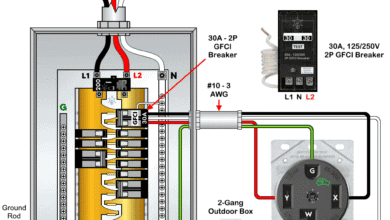 How to Wire a 30A, 125V/250V – NEMA 14-30 Receptacle
How to Wire a 30A, 125V/250V – NEMA 14-30 Receptacle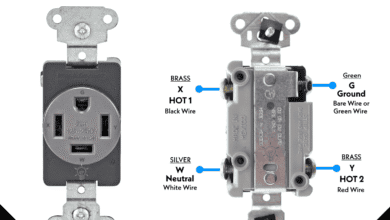 How to Wire a 20A, 125V/250V – NEMA 14-20 Receptacle
How to Wire a 20A, 125V/250V – NEMA 14-20 Receptacle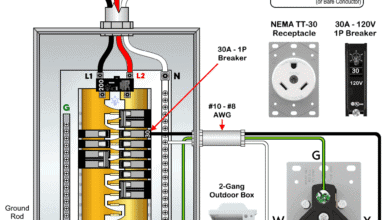 How to Wire NEMA TT-30 Receptacle for RVs & Travel Trailers
How to Wire NEMA TT-30 Receptacle for RVs & Travel Trailers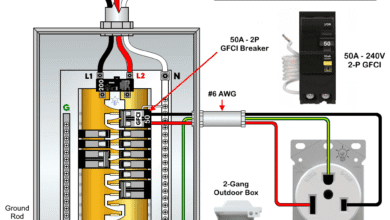 How to Wire a 50A – 250V, NEMA 6-50 Receptacle
How to Wire a 50A – 250V, NEMA 6-50 Receptacle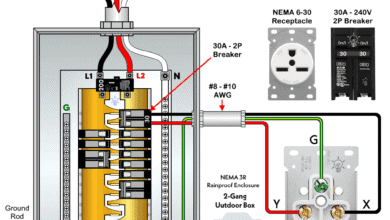 How to Wire a 30A – 250V, NEMA 6-30 Receptacle
How to Wire a 30A – 250V, NEMA 6-30 Receptacle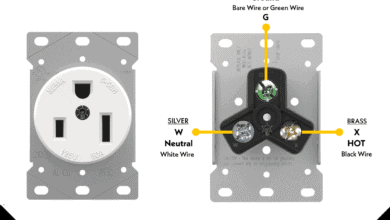 How to Wire a 50A – 125V – NEMA 5-50 Receptacle
How to Wire a 50A – 125V – NEMA 5-50 Receptacle